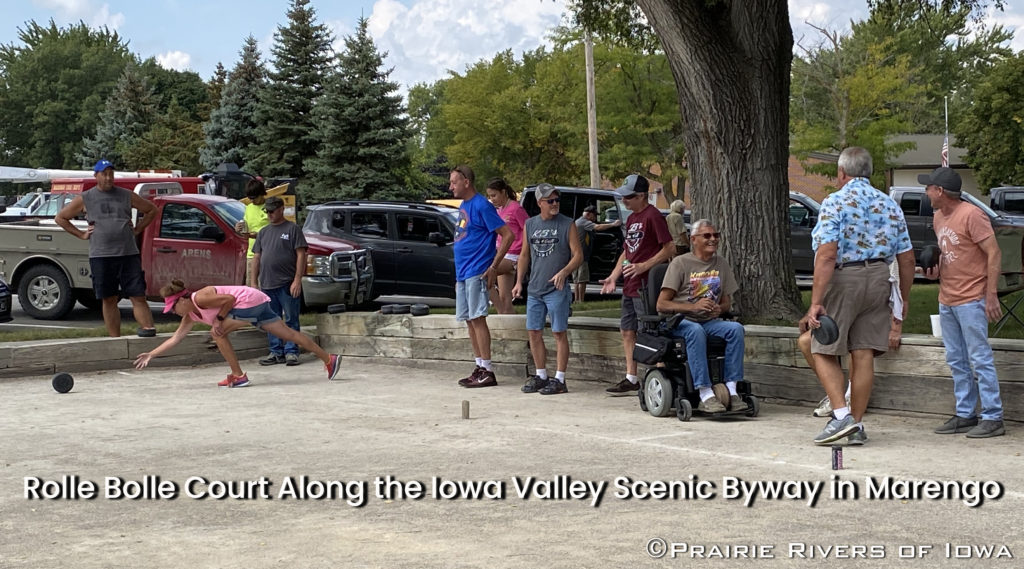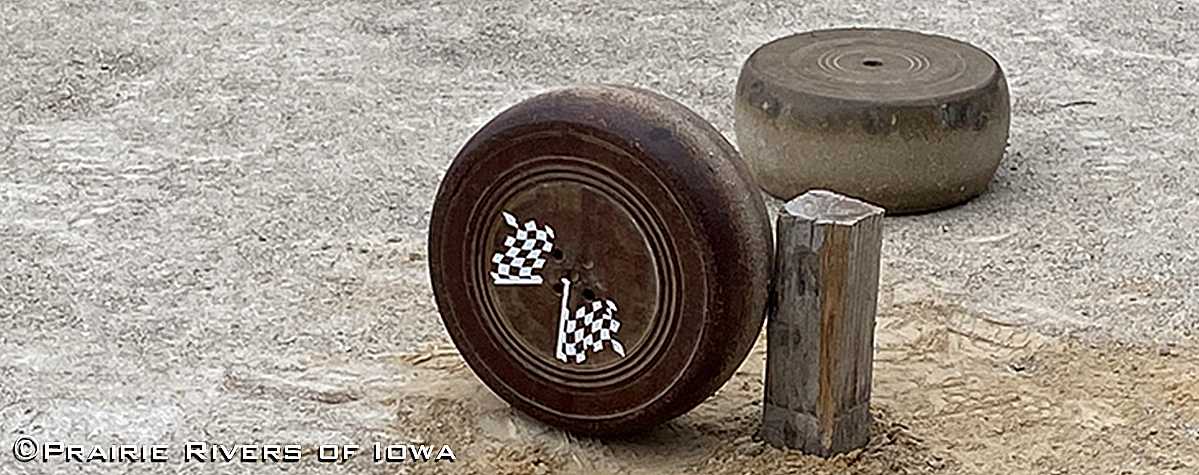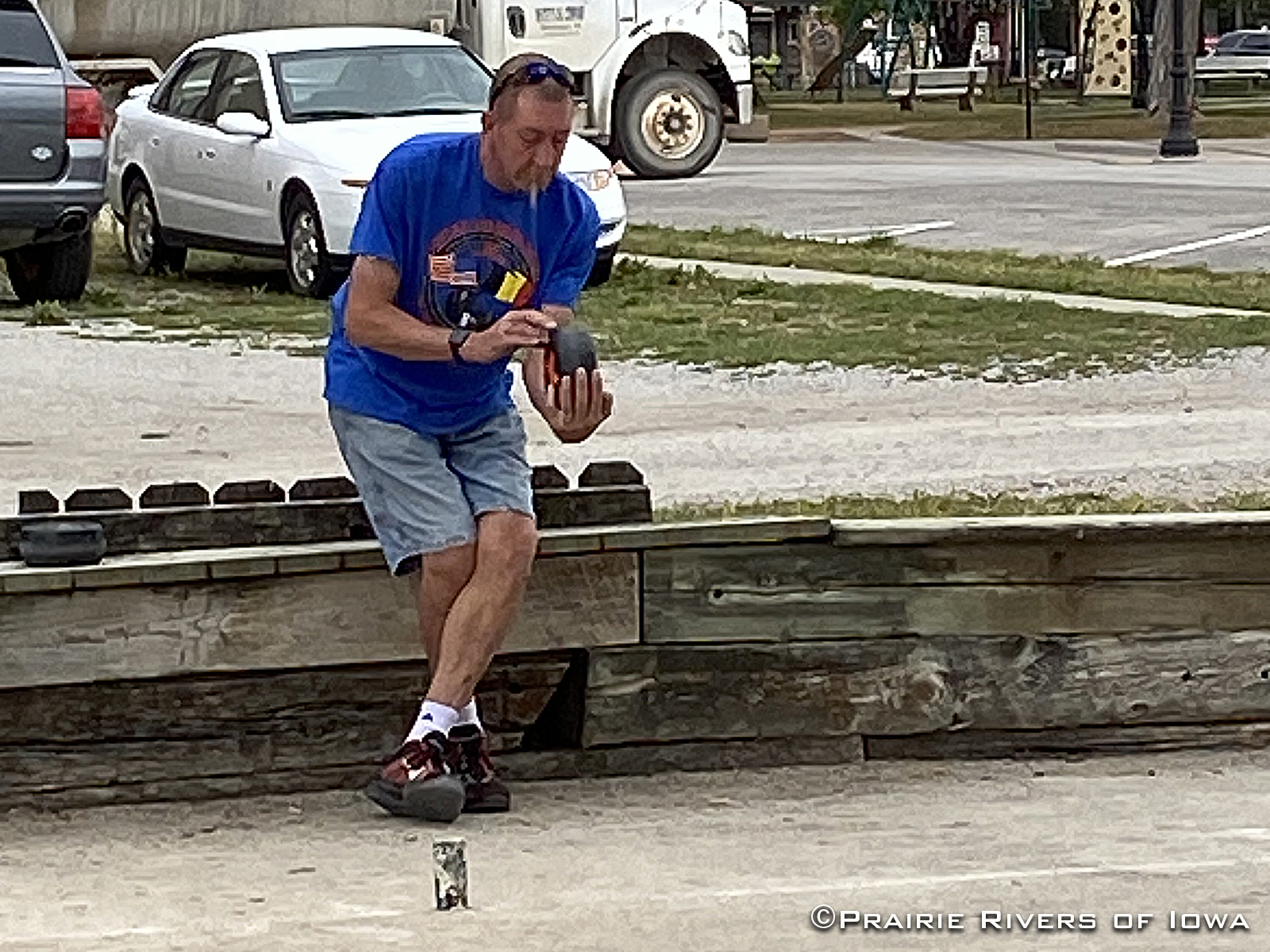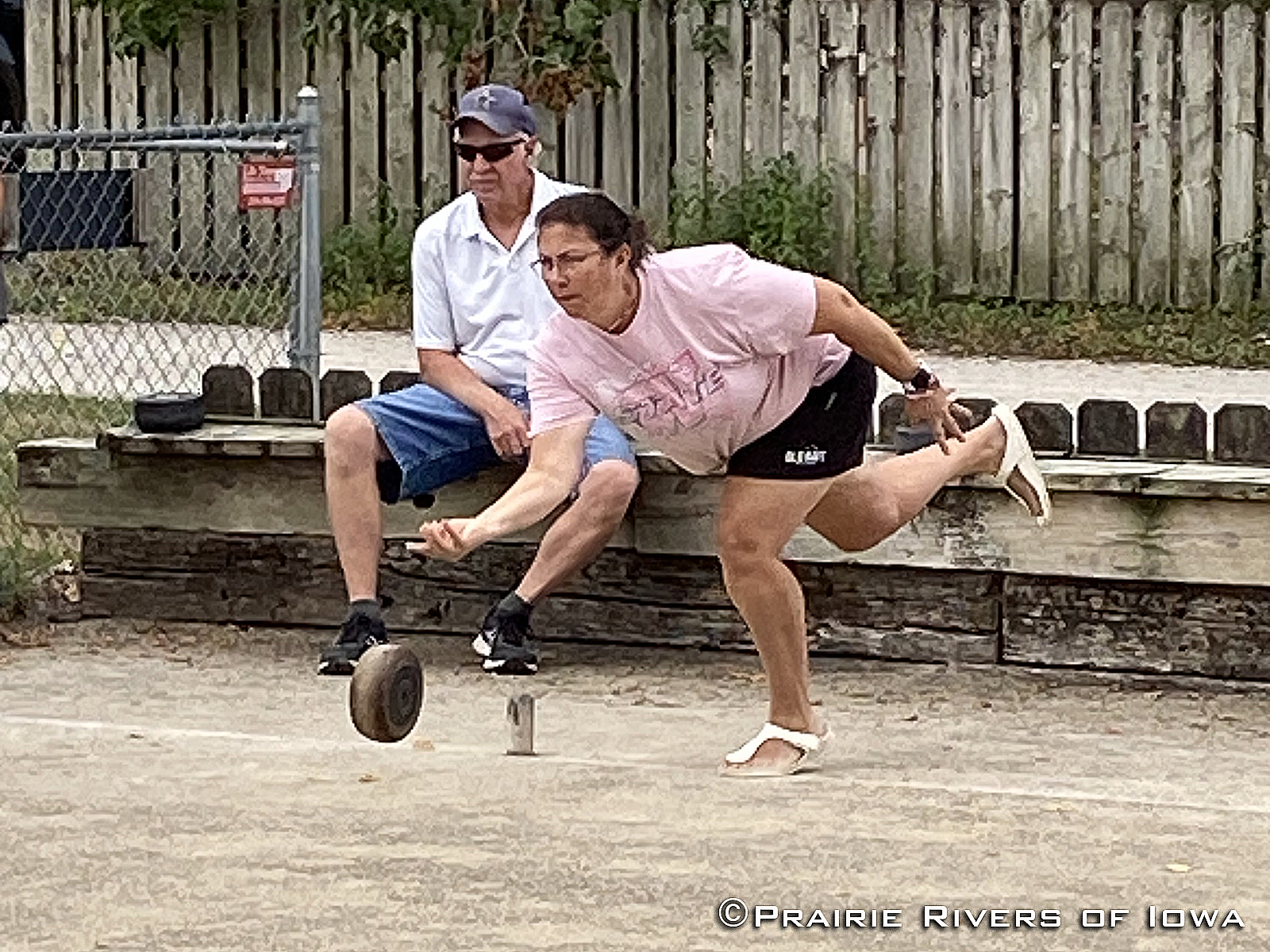Recently, I had the opportunity to hang out with the group of Rolle Bolle enthusiasts who play this game every weekend of the summer rotating between courts in the Iowa Valley, Minnesota, and Illinois. They are such a welcoming group who made me feel at home. If only I hadn’t been fighting a cold at the time, I would have accepted the beverage of Rolle Bolle choice and then been able to call myself family. This truly felt like a family sport, not only because there was a mom, dad, and daughter playing, and many of them were related, but because they encouraged each other, gave tips, and maybe had a little bit of rivalry.
Those of you who have grown up in the Iowa Valley have most likely heard of Rolle Bolle and know how the game is played. For this central Iowan, I had never heard of the game and was quite surprised by many details I hadn’t noticed just by viewing the game in photos.
In simplistic terms, the game is played by teams of three or four people rolling bolles down an alley aiming to land their bolles closest to a pole. The object is to have the most bolles* the closest distance to the pole than the other team by the end of everyone’s turn.
*One of the defining characteristics of Rolle Bolle is the beveled wheel-like shape of the ball or bolle. Bolles are manufactured in a way so that they do not roll straight but in a curved, elliptical path.
The 10 Things I Learned
1: Although the bolle looks like a greatly enlarged hockey puck to me, it is not the same diameter on each side. I even rolled the bolle down our hallway here at Prairie Rivers and did not notice that there is a smaller side and a larger side. So why the beveled shape? The origin of the shape is not known; a fun theory is that the first bolle was a wheel of Gouda cheese, although this is probably not true. Whatever the origin, the shape is what makes the game unique to horseshoes, bocce, bowling, or curling.
2: There is not a one-size-fits-all regulation size for the bolle. Although they can weigh no less than five and no more than 9.5 pounds and measure no larger than 8” in diameter, they can be different for each player. Doesn’t this give someone with a larger bolle an advantage of being closer to the pole? “Not really,” I am told. A smaller bolle may be able to creep between thrown bolles better, a larger one may be lighter and more easily bumped out of position. What it boils down to is the boller knowing their bolle’s weight and turn and their aim, strategy, skill, and luck.
3: Bolles are not all made of the same material. Nineteenth-century bolles were made from ironwood, a hard dense type of wood. Fiberglass has also been used. Belgian bolles today are mostly made of phenolic resin which produces a lighter and chip-resistant bolle. Most bolles in the United States are made from rubber and there are only two makers in the United States. One of those makers, De Pauw, makes bolles that are rubber in the center and phenolic material on the outside; he calls it the “Wonder Bolle.”
4: Just as there isn’t one regulation size or material for the bolles, there isn’t a regulation for the material or slope of the courts. The court must be 42’ long with two stakes placed 6’ from the backstop (30’ between stakes). Most of the outdoor alleys are crushed limestone material that may get rolled before a tournament in an attempt to smooth it out. Alleys can also be made from clay, dirt, sand, grass, or even carpet (usually on an indoor court). And the slope can range from court to court, which as you can imagine will change the way you roll the bolle. Remember that beveled shape?
5: The backstops must be 6’ from the pole but a barrier behind the backstop can be any distance. Think of a pit with railroad ties surrounding it. The distance from the backstop line (which your foot can cross but not go over while throwing) and the railroad tie can be different and depending on the length of your legs, this can give you space to take a “running” start or hinder your pace and form when aiming the bolle. One particular boller who has long legs was starting his run cross-legged. When I asked why, he explained that he has to start his approach this way because if the backcourt is shorter, he can’t get a comfortable approach. So by starting cross-legged, he can step out giving him more space to then take his next steps.
6: You can roll the bolle or you can shoot it! Shooting the bolle is exciting. Perhaps I see it that way because everyone kept telling me to “step back” and “heads up.” Or because the young man shooting kept breaking the poles. Or just maybe, because when I tried to roll the bolle, it went way too far (I have too much power behind my bolle roll). “Just roll it,” I was told while I was thinking, “I am.”
There are typically three types of players with different roles. The “lead person,” the middle person (no official name), and the “shooter.” The lead gets to make the team’s strategic decisions. The lead and the middle person typically roll the bolle to get it close to the pole. The shooter gets to shoot at an opponent’s bolle to knock it out of the area closest to the pole, or at a teammate’s bolle to knock it closer. More power is used when shooting. And a “step back” is shouted to the crowd.
7: There are Rolle Bolle courts in Belle Plaine, Marengo, Victor, Ladora, Blairstown, and Marion. And several have closed in just the last three years.
8: Bollers have a love-hate relationship with the game. One boller I visited with kept saying, “I hate this game.” Then he would tell me that he tries to play the game seven days a week. He was the only player from Illinois this weekend. After explaining that you can’t master this game because of all the variables, all of the bollers expressed how they love it. A love-hate for sure!
9: This “thing” about Rolle Bolle is something that I know, and you may not know. Did you know that with a library card, you can check out a set of Rolle Bolle bolles at the Marengo Public Library? Yep.
10: This is not the last time that I will be writing about Rolle Bolle. ![]()
Thank you to all of the Rolle Bolle bollers who were at the Marengo Court on September 16th. We will continue to educate and encourage a new generation of bollers to carry on your legacy. — Jeanie





